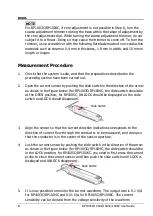
RIGOL
IV
RP1003C/1004C/1005C/1006C User Guide
Safety Precautions
DANGER
1.
Do not measure around a bare conductor. Doing so may result in short-circuit or
electric shock. Take measurements at a location on an insulated wire where
there is sufficient insulation for the circuit voltage.
2.
When measuring current that contains high-frequency components, refer to
Appendix 2 Relation between Max Input Current and Frequency
.
Never measure any current that exceeds the rated current.
3.
Using the probe in strong high-frequency magnetic fields may cause the device
to become abnormally hot, resulting in fire, equipment damage, or burns (see
Specifications
).
4.
Observe the following to avoid electric shock and short circuit.
1)
Connect the probe to the power adapter and waveform measurement
instrument first, and then connect the probe to the active lines to be
measured.
2)
When the sensor is opened, do not short circuit the conductor being
measured.
3)
Be careful to avoid damaging the insulation surface while taking
measurements.
4)
Before clamping the conductor being measured, make sure that the
insulation on the conductor is undamaged. Also, take care not to damage
the insulation when clamping the conductor. Any damage to the insulation
could cause an electric shock.
5)
The probe is made for use with the RP1000P power adapter.
6)
To prevent fire, avoid damage or burns of the measurement object/device,
pay attention to the following cautions when measuring high-frequency
currents or currents that contain high-frequency components:
Eddy current loss may cause heating of the sensor head.
Dielectric heating may cause heating of cord insulation and other
materials.
7)
The probe should only be connected to the secondary side of a breaker, so
the breaker can prevent an accident if a short circuit occurs. Connections
should never be made to the primary side of a breaker, because
unrestricted current flow could cause a serious accident if a short circuit
occurs.
8)
Be sure to observe all operating precautions for the waveform
measurement instrument and other measurement instruments to which
the probe is connected.
9)
When using a measurement instrument that does not provide isolation
Summary of Contents for RP1003C
Page 1: ...User Guide RP1003C 1004C 1005C 1006C Current Probe Sept 2020 RIGOL TECHNOLOGIES CO LTD ...
Page 2: ......
Page 10: ......
Page 29: ...RIGOL RP1003C 1004C 1005C 1006C User Guide 19 RP1005C RP1006C ...
Page 31: ...RIGOL RP1003C 1004C 1005C 1006C User Guide 21 RP1005C RP1006C ...
Page 33: ...RIGOL RP1003C 1004C 1005C 1006C User Guide 23 RP1005C RP1006C ...







































